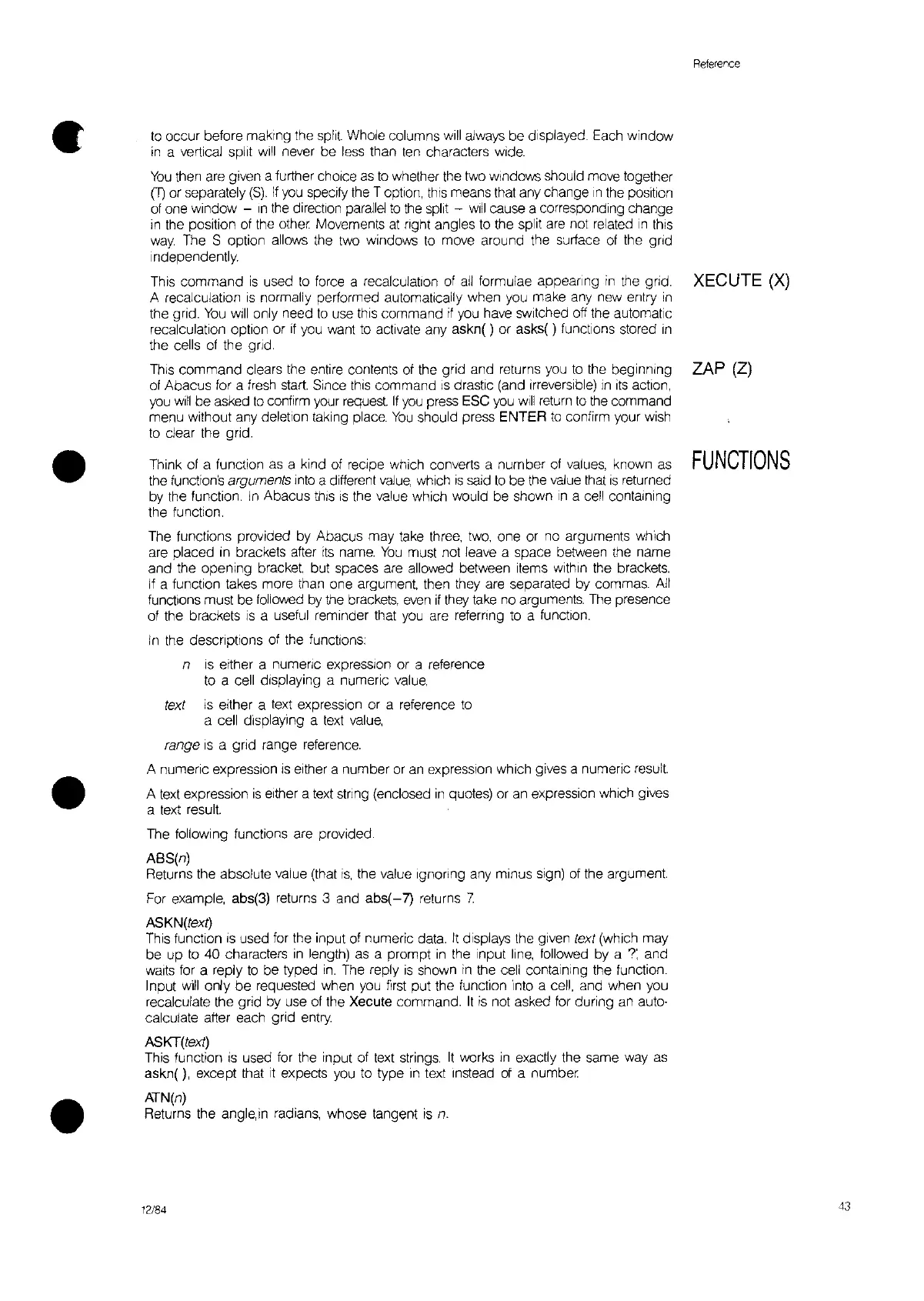•
•
•
Reference
to
occur
before
making
the spilt Whole columns will always
be
displayed Each
window
in
a vertical spilt will never
be
less than ten characters wide.
You
then are given a further choice as
to
whether the two windows should move fogether
(T)
or separately
(S).
If
you specify the T option, this means that any
change
In
the position
of one window -
In
the direction parallel
to
the split
~
will cause a corresponding change
in the position of the other Movements at rrght angles to the split are not related
In
this
way.
The S option allows the two windows
to
move around the surface of the grrd
Independently.
This
command
is
used
to
force a recalculation of all formulae appearrng
in
the grrd. XECUTE
(X)
A recalculation
IS
normally performed automatically when you make any new entry in
the grid.
You
will only need
to
use this
command
if
you have switched off the aufomatic
recalculation option or
if
you want to activate any askn( ) or asks( ) functions stored in
the cells of the grrd.
This
command
clears the entire contents of the grid and returns you
to
the beginning ZAP (2)
ot
Abacus
for a fresh start. Since this
command
IS
drastic (and irreversible) in
its
action,
you
will
be
asked
to
confirm your request
If
you press ESC you
will
return
to
the
command
menu
without any deletion taking place.
You
should press ENTER
to
confirm your wish
to clear the grrd.
Think of a function as a kind of recipe which converts a
number
of values, known as
FUNCTIONS
the function's
arguments
Into a different
value,
which
is
said
to
be
the value that
is
returned
by the function. In
Abacus
this
IS
the value which would be shown
In
a cell containing
the function.
The functions provided
by
Abacus
may
take three, two,
one
or no arguments which
are
placed
In brackets after
its
name.
You
must
not leave a space between the name
and
the
opening
bracket. but spaces are allowed between Items within the brackets.
If
a function takes more than one argument. then they are separated
by
commas. All
functions
must be followed by the brackets, even
if
they take no arguments. The presence
of the brackets is a useful reminder that you are referrrng to a function.
In the descriptions of the functions:
n is either a numeric expression
or
a reference
to a cell displaying a
numerrc
value,
text
Is
either a text expression or a reference to
a cell
display'lng a text value,
range
is a grrd range reference.
A numeric expression
IS
either a
number
or an expression which gives a numerrC result
A text expression
is
either a text strrng (enclosed
in
quotes) or an expression which gives
a text result
The following functions are provided.
ASS(n)
Returns the absolute value (that
is,
the value Ignorrng any minus sign) of the
argument
For example, abs(3) returns 3 and abs(
-7)
returns
7.
ASKN(text)
This function
IS
used for the input of numeric data.
It
displays the given text (which
may
be
up
to
40
characters in length) as a
prompt
in the input line, followed
by
a
?:
and
walts for a reply
to
be typed
in.
The reply
is
shown
in
the cell containing the function.
Input will
only
be
requested when you first put the function Into a cell, and when you
recalculate the grid
by
use of the Xecute
command.
It
is
not asked for during an auto-
calculate after each grrd entry
ASKT(text)
This function
is
used for the Input of text strings.
It
works
,n
exactly the same way as
askn(),
except that
it
expects you to
type
in text Instead of a
number
ATN(n)
Returns the angle,in radians, whose tangent
is
n.
12/84
43
